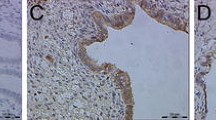Abstract
Purpose
This study aimed to explore whether estrogen-related receptors α (ERRα) can prognosticate the occurrence and development of ovarian endometriosis (EMs) as a non-invasive biomarker.
Methods
The ectopic and its’ correspond eutopic endometria from 47 patients with ovarian EMs and the control normal endometria from 32 cases were collected and detected the mRNA expression of ERRα by RT-qPCR. The serum protein of ERRα were tested by ELISA. The menstrual cycle, ovarian cyst sizes, relative clinical tumour markers, such as CA125, CA19-9 and HE-4, and other demographic data were also involved into analysis in these patients by SPSS 22.0 (IBM, Chicago, IL, USA).
Results
The ERRα mRNA expression in ectopic endometria were significantly lower than it in eutopic endometria (P < 0.05) and the normal endometria (P < 0.05). Similarly, the serum ERRα levels in patients with EMs were significantly lower than it in control group (P < 0.01). Moreover, the serum ERRα levels were decreasing with the increasing of the pathological stages and ovarian cyst sizes. While, the serum CA125, CA19-9, CA125/ERRα ratio and CA19-9/ERRα ratio in the study group were significantly higher than those in the control group (all P < 0.01).
Conclusion
The expression of ERRα is correlated with the development of ovarian EMs pathological stages and ovarian cyst sizes and can be used as a novel and non-invasive biomarker for evaluating the progression of ovarian EMs.






Similar content being viewed by others
References
Giudice LC (2010) Clinical practice. Endometriosis. N Engl J Med 362:2389–2398
Vercellini P, Vigano P, Somigliana E, Fedele L (2014) Endometriosis: pathogenesis and treatment. Nat Rev Endocrinol 10:261–275
Huhtinen K, Desai R, Stahle M et al (2012) Endometrial and endometriotic concentrations of estrone and estradiol are determined by local metabolism rather than circulating levels. J Clin Endocrinol Metab 97:4228–4235
Ya G, Minghui S, Xueni Ma et al (2019) Seven hormonal biomarkers for diagnosing endometriosis: a meta-analysis and adjusted indirect comparison of diagnostic test accuracy. J Minim Invasive Gynecol 26(6):1026–1035
Tanida T, Matsuda KI, Yamada S, Hashimoto T, Kawata M (2015) Estrogen-related receptor beta reduces the subnuclear mobility of estrogen receptor alpha and suppresses estrogen-dependent cellular function. J Biol Chem 290:12332–12345
Yang Y, Yang W (2017) Epithelial-to-mesenchymal transition in the development of endometriosis. Oncotarget 8:41679–41689
Wei W, Schwaid AG, Wang X et al (2016) Ligand activation of ERRalpha by cholesterol mediates statin and bisphosphonate effects. Cell Metab 23:479–491
Thewes V, Simon R, Schroeter P et al (2015) Reprogramming of the ERRalpha and ERalpha target gene landscape triggers tamoxifen resistance in breast cancer. Cancer Res 75:720–731
Matsushima H, Mori T, Ito F et al (2016) Anti-tumor effect of estrogen-related receptor alpha knockdown on uterine endometrial cancer. Oncotarget 7:34131–34148
Wang C, Hsu W, Tai C (2017) Antimetastatic effects of cordycepin mediated by the inhibition of mitochondrial activity and estrogen-related receptor α in human ovarian carcinoma cells. Oncotarget 8:3049–3058
Cavallini A, Resta L, Caringella AM, Dinaro E, Lippolis C, Loverro G (2011) Involvement of estrogen receptor-related receptors in human ovarian endometriosis. Fertil Steril 96:102–106
Han JY, Lee EJ, Jee BC, Kim SH (2018) Menstrual characteristics in Korean women with endometriosis: a pilot study. Obstet Gynecol Sci 61:142–146
Foster W (2016) Diagnosing endometriosis:CA125 rules in, but not out. BJOG 123:1769
Bombail V, MacPherson S, Critchley HO, Saunders PT (2008) Estrogen receptor related beta is expressed in human endometrium throughout the normal menstrual cycle. Hum Reprod 23:2782–2790
Luo J, Sladek R, Carrier J, Bader J-A, Richard D, Giguère V (2003) Reduced fat mass in mice lacking orphan nuclear receptor estrogen-related receptor α. Mol Cell Biol 23:7947–7956
Cong J, Li P, Zheng L, Tan J (2016) Prevalence and risk factors of infertility at a rural site of Northern China. PLoS ONE 11:e0155563
Acimovic M, Vidakovic S, Milic N et al (2016) Surviving and VEGF as novel biomarkers in diagnosis of endometriosis. J Med Biochem 35:63–68
Mabrouk M, Elmakky A, Caramelli E et al (2012) Performance of peripheral (serum and molecular) blood markers for diagnosis of endometriosis. Arch Gynecol Obstet 285:1307–1312
Kurdoglu Z, Gursoy R, Kurdoglu M, Erdem M, Erdem O, Erdem A (2009) Comparison of the clinical value of CA 19–9 versus CA 125 for the diagnosis of endometriosis. Fertil Steril 92:1761–1763
Agic A, Djalali S, Wolfler MM, Halis G, Diedrich K, Hornung D (2008) Combination of CCR1 mRNA, MCP1, and CA125 measurements in peripheral blood as a diagnostic test for endometriosis. Reprod Sci 15:906–911
Tuten A, Kucur M, Imamoglu M et al (2014) Copeptin is associated with the severity of endometriosis. Arch Gynecol Obstet 290:75–82
Wei WD, Ruan F, Tu FX et al (2013) Expression of suppressor of cytokine signaling-3 and caspase-3 in endometriosis and their correlation. Zhonghua Bing LI Xue Za Zhi 42:515–518
Giguere V (2008) Transcriptional control of energy homeostasis by the estrogen-related receptors. Endocr Rev 29:677–696
Yang C, Zhou DJ, Chen S (1998) Modulation of aromatase expression in the breast tissue by ERR alpha-1 orphan receptor. Cancer Res 58:5695–5700
Funding
This research did not receive any specific grant from funding agencies in the public, commercial, or not-for-profit sectors.
Author information
Authors and Affiliations
Contributions
CL: study designation and manuscript writing; YJC: manuscript writing and statistical analysis; MC: data interpretation; XDM: laboratory analysis; BHD: statistical analysis; PMS: critically revised the article and supervised the study.
Corresponding author
Ethics declarations
Conflict of interest
The authors have no conflict of interest to declare.
Ethical approval
The study was approved by our institutional review board (2016-038).
Informed consent
Informed consent was obtained from all individual participants included in the study.
Additional information
Publisher's Note
Springer Nature remains neutral with regard to jurisdictional claims in published maps and institutional affiliations.
Rights and permissions
About this article
Cite this article
Liu, C., Chen, Y., Chen, M. et al. A novel non-invasive molecular biomarker in ovarian endometriosis: estrogen-related receptor α. Arch Gynecol Obstet 302, 405–414 (2020). https://doi.org/10.1007/s00404-020-05611-5
Received:
Accepted:
Published:
Issue Date:
DOI: https://doi.org/10.1007/s00404-020-05611-5




